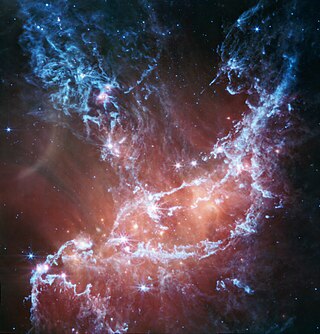Top Qs
Timeline
Chat
Perspective
NGC 346
Open cluster in the constellation Tucana From Wikipedia, the free encyclopedia
Remove ads
NGC 346 is a young[4] open cluster of stars with associated nebula located in the Small Magellanic Cloud (SMC) that appears in the southern constellation of Tucana. It was discovered August 1, 1826 by Scottish astronomer James Dunlop. J. L. E. Dreyer described it as, "bright, large, very irregular figure, much brighter middle similar to double star, mottled but not resolved".[5] On the outskirts of the cluster is the multiple star system HD 5980,[6] one of the brightest stars in the SMC.
Remove ads
Description
This cluster is located near the center of the brightest H II region in the SMC, designated N66.[7] This is positioned in the northeast section of the galactic bar.[8] Stellar surveys have identified 230 massive OB stars in the direction of this cluster.[4] 33 of the cluster members are O-type stars, with 11 of type O6.5 or earlier.[8] The inner 15 pc radius of the cluster appears centrally condensed, while the area outside that volume is more dispersed.[9] The youngest cluster members near the center have ages of less than two million years,[7] and observations suggests the cluster is still engaged in high mass star formation.[7] The cluster star formation rate is estimated at (4±1)×10−3 M☉ yr−1.[9]
Remove ads
Image Gallery
- Image of NGC 346 with a 30 arcminute wide field of view showing the wispy nebular structure around it.
- NGC 346 imaged by the Hubble Space Telescope
- James Webb Space Telescope image of star formation in NGC 346
Remove ads
See also
References
External links
Wikiwand - on
Seamless Wikipedia browsing. On steroids.
Remove ads




